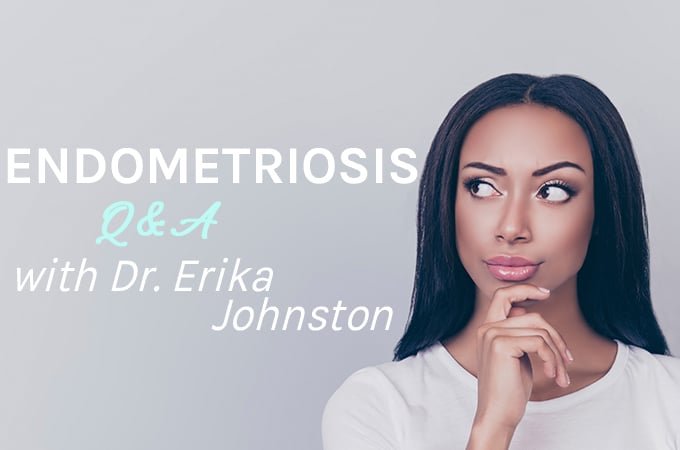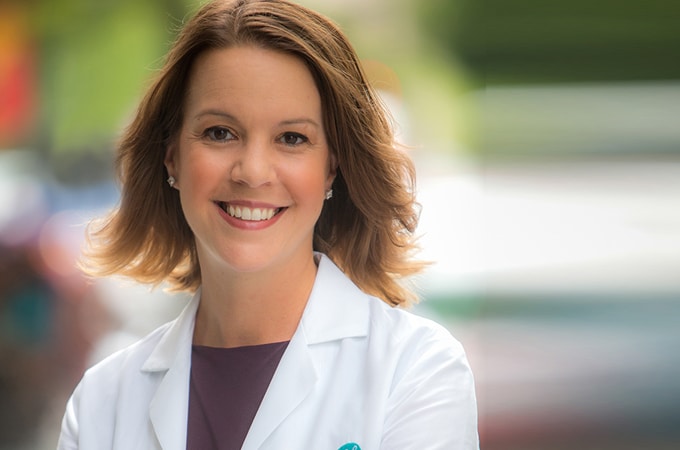Sharecare, a digital health company, recently interviewed Dr. Erika Johnston of SGF Richmond about the key facts about endometriosis and what she wants every woman to know.
Endometriosis is a diagnosis common among girls and women in their reproductive years. It is a condition in which endometrial tissue (tissue that lines the inside of the uterus) grows outside the uterus and eventually sheds into the abdominal cavity. Inflammation occurs in the areas where the blood pools, forming scar tissue. When the endometrial tissue forms on other reproductive organs aside from the inside of the uterus, it interferes with ovulation, tubal transport, and embryo quality.
Q: What are the warning signs of endometriosis?
Dr. Johnston: “The most common symptom for women with endometriosis is painful periods. Having pain with bowel movements, particularly during menstruation, that’s also a very big red flag. Similarly, pain with urination and pain with deep penetrating intercourse are two more key features of a woman who’s at high risk for having endometriosis. Having these symptoms and also trying to conceive for more than a year without success is an additional red flag that a woman is at high risk.”
Q: How can women distinguish between normal cramps and endometriosis?
Dr. Johnston: “If you talk to any woman she’ll say, ‘Oh, yeah, I have cramping when my menstrual period starts.’ Cramping that can be treated with a localized heating pad and over the counter medication is typical. But it’s not normal when a woman is unable to go to work or unable to go to school at the time of onset of her menstrual period because the pain is so severe and does not respond to typical over the counter medication.”
Q: Endometriosis involves more than just the uterus. Where can endometrial tissue implant in the body?
Dr. Johnston: “Unfortunately, the whole abdominal cavity is at risk when a woman has endometriosis. For most women, we think that not only do they bleed externally when their menstrual period comes vaginally, but also there’s blood that actually goes backwards through the Fallopian tube and can sometimes implant on the outside of the uterus. More commonly, this tissue can implant on the ovaries themselves and on the tissue behind the uterus. It can also travel as far north as the edge of the liver or the lower edge of the lungs.”
Q: Do we know why this happens?
Dr. Johnston: “We think most people actually have blood flow that goes backwards, but not all women have endometriosis. So, there is something on a genetic or cellular level that’s different. There are a few theories behind how it occurs. One is that endometrial tissue can actually spread through the lymphatic system. Another theory is that it travels through the blood vessels. This would help explain some unique cases where women actually have endometriosis tissue in their lungs, or oddly enough, in their brains. A third theory is that perhaps the tissue was always there—even during fetal development. It just got the wrong signal about where it was supposed to go and implanted in the wrong place. It’s not clear which theory is correct but certainly the more investigation we do, the more we understand that this tissue, which looks like the tissue from the inside lining of the uterus, acts a bit differently.”
Q: How is the condition diagnosed?
Dr. Johnston: “The ‘gold standard’ for diagnosis is doing a laparoscopy and seeing a lesion but certainly less invasive investigations can be performed first. We could start very simply by just taking a history. The next step would be an internal pelvic examination just to feel the pelvic structures. Then, if there is a concern about pain related to endometriosis, most OB/GYNs will recommend an ultrasound evaluation of the pelvis. All of these things can be done first before we consider surgery. And in fact, two of our governing groups that give us guidance for good obstetrical care, both in Canada and the U.S., suggest that if someone’s symptoms are likely enough to be related to endometriosis, presumptive medical treatment can actually start before a surgical procedure is performed to confirm the diagnosis.”
Q: Many women struggle for years with endometriosis before they are finally diagnosed. Why?
Dr. Johnston: “It shouldn’t take years to diagnose endometriosis, but it does. All too often women’s gynecologic concerns are marginalized, and people are concerned that their doctor is going to rush right into surgery. I think as healthcare providers we probably have not historically done a very strong job at investigating these concerns. But I have to say, if a woman is aware that it might be a problem or if she’s aware that she is having symptoms, then it shouldn’t have to take years to diagnose it. I think we can do better.”
Q: Does having endometriosis mean a woman can’t get pregnant?
Dr. Johnston: “Not all women with endometriosis are infertile. What we worry about with endometriosis is distortion of the pelvic anatomy that makes it hard for the Fallopian tube to successfully pick up an egg from the ovary. Endometriosis can also implant in the ovaries and form a cyst. Unfortunately, this can lower a woman’s egg count and cause infertility. The good news is that most women with endometriosis don’t have these conditions, so the disease doesn’t have a negative impact on their fertility. My hope for every patient with endometriosis is that she never needs my services for fertility treatment. Seeking care early on is important, so that the disease doesn’t progress to a stage that would involve the pelvic structures, increasing the likelihood of infertility.”
Watch: SGF’s New On-Demand Webinar, Getting Pregnant with Endometriosis
Q: Is surgery the mainstay of treatment for endometriosis?
Dr. Johnston: “There’s a lot of focus on endometriosis now and there are some great minimally invasive surgical strategies for women with high amounts of pelvic pain or distortion of the anatomy within their pelvis because of the presence of endometriosis. But surgery is by no means the only option. In fact, often we discourage it as an option, depending on a patient’s unique circumstances because it may not lead to resolution of their symptoms. We really try and use medication first and defer using surgery until medication has not been effective.”
Q: What medications are used to manage the condition?
Dr. Johnston: “There definitely are really thoughtful medical management strategies that reduce the amount of menstrual cycles that a woman has across her lifetime and improve her pain symptoms and prevent progression of her disease. This may involve continuous birth control pills or injectable contraceptives, or daily oral agents that are taken to try and reduce estrogen levels. Many of those can be very effective.”
Q: Are there any lifestyle changes that could help ease endometriosis symptoms?
Dr. Johnston: “From a non-medication, non-surgical standpoint, I think my view is that engaging in exercise and having supportive social networks can be very helpful. On the difficult pain days, it could result in a reduction in what women perceive as the severity of their symptoms.”
Q: So, there are treatments but no cure for endometriosis?
Dr. Johnston: “I always tell my patients that just like diabetes, this will always be something that they will have to consider and think about, which is unfortunately a little disheartening for people because no one really wants to have a chronic condition.”
Q: Won’t symptoms disappear after menopause?
Dr. Johnston: “Any woman who’s menstruating is at risk for endometriosis, but menopause doesn’t mean you’re going to be free of the condition either. Many of my patients that have been long-term sufferers of endometriosis are thrilled to go through menopause because they assume they finally won’t have to manage the condition anymore. Unfortunately, women who have advanced disease can still have symptoms from their endometriosis even in the menopausal time period.”
Q: What do you want to say to women who are struggling with endometriosis or suspect that they have the condition?
Dr. Johnston: “Many women suffer for years and have normalized their severe symptoms. It’s important to have an open dialogue with your healthcare provider about what you are experiencing, how it’s affecting your daily life, and ability to be productive. If you’re already in the care of a gynecologist who you feel is not responsive to your concerns or questions, don’t be afraid to seek a second opinion as well. A second physician might be able to provide a different perspective or treatment strategy that better resonates with your needs.”
To schedule an appointment with Dr. Johnston or any of our Shady Grove Fertility physicians, please call 1-877-971-7755 or fill out this brief form.






